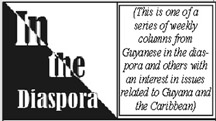By Samuel Braithwaite
Samuel Brathwaite is a lecturer in the
Department of Economics, the University
of the West Indies, Mona
Introduction
In May of this year, I was asked by Prof. Vibert Cambridge to participate, via Skype or pre-recorded video, in the Mittelholzer literary event in celebration of Guyana’s Jubilee year of independence. The following are my reflections on Mittelholzer and his works. It’s not a literary analysis. Indeed, there’s much more of his work that I’m yet to read, and I do not possess the skills of a literary critic.
 In 2009, the Caribbean Beat, in its celebratory 100th issue, did a feature on Edgar Austin Mittelholzer. The same issue featured Caribbean music icon, Bob Marley. Deliberate, or not, Mittelholzer was in esteemed company, and rightfully so. Of Mittelholzer, the Caribbean Beat wrote, “Edgar Mittelholzer, born on December 16, 1909, was the earliest recorded author from the region to make a living – and a very precarious one it would turn out to be – from his pen.” In my view, Mittelholzer was a Caribbean literary revolutionary whose tenacity allowed him to overcome several barriers and pave the way for other Caribbean writers to follow.
In 2009, the Caribbean Beat, in its celebratory 100th issue, did a feature on Edgar Austin Mittelholzer. The same issue featured Caribbean music icon, Bob Marley. Deliberate, or not, Mittelholzer was in esteemed company, and rightfully so. Of Mittelholzer, the Caribbean Beat wrote, “Edgar Mittelholzer, born on December 16, 1909, was the earliest recorded author from the region to make a living – and a very precarious one it would turn out to be – from his pen.” In my view, Mittelholzer was a Caribbean literary revolutionary whose tenacity allowed him to overcome several barriers and pave the way for other Caribbean writers to follow.
My “encounters” with Mittelholzer
My first “encounter” with Mittelholzer occurred before I had even touched one of his brilliant novels. I grew up in St. Ann’s Street, New Amsterdam, two streets south of Coburg Street, where Mittelholzer lived. Coburg street has since been renamed, LFS Burnham Street. My mom had a family friend who lived in that street. On a few occasions I would have accompanied her to visit the friend. On one of those trips she would have pointed out Mittelholzer’s childhood home to me, and noted that he was a famous writer.
My second “encounter” with Mittelholzer, could very well have been my first. I’m not sure. Anyway, sometime in the late 80’s into the early 90’s, the then Guyana Broadcasting Corporation (GBC) carried a series of radio adaptations of My Bones and my Flute – arguably Mittelholzer’s most famous work. In those days, it wasn’t Sunday night unless the flute was heard. I never sat down to listen to the radio presentations, but the eerie sound of the flute, and the announcer’s introduction, “my bonessss, and my flute,” were hard to escape. At some point I was told that it was a “jumbie story,” to use local parlance.
My third “encounter” with Mittelholzer occurred in high school. A Morning at the Office and Corentyne Thunder were some of the books I received from the school’s stock prior to the start of fourth form. I read A Morning at the Office relatively quickly. What struck me, was the fact that an entire book could be based on one morning at an office. That an author could find so much to say about the characters in a single space, in a single morning, was interesting to me. Corentyne Thunder was a lengthier read. It centred on the relationship between a young couple, from two different races, and classes. Unlike A Morning at the Office, which was set in Trinidad, this story was set in Guyana. Of more importance to me, it was set in my home county, Berbice. It must have been the first book I read with Berbice as its setting. The themes of racism, class prejudice and rejection, central to Mittelholzer’s works, were very evident. However, these themes were not particularly overwhelming for me, and did not detract from my enjoyment of both books. Having already read Miguel Street, A Brighter Sun and Hurricane, it was great to read something home grown. A sense of pride ensued, and still does.
About 15 years after I left high school, I had my fourth “encounter” with Mittelholzer. I was completing graduate studies at the time, and decided to read My Bones and My Flute. I’m not entirely sure what prompted me to do so. It might have been some discussion of Mittelholzer in Guyana’s print media. I thoroughly enjoyed the book. It was hard to put down. Having whetted my appetite for his works, I went looking for more, and that’s when I found A Swarthy Boy. It was Mittelholzer’s autobiography on his early days in New Amsterdam. I had never heard of this title before. I was overjoyed and annoyed at the same time. Why was I never exposed to this book in school?
A Swarthy Boy brought back wonderful memories of my childhood. While Mittelholzer grew up in a different New Amsterdam than the one I knew, I connected with the accounts of his early life. Mittelholzer’s grandfather was the first Guyanese Lutheran Priest. He served as priest at the Ebenezer Lutheran Church, New Amsterdam. The establishment of Ebenezer in 1743 marked the official beginning of the Evangelical Lutheran Church of Guyana (ELCG). Church history says that circa 1800 the Ebenezer Church was floated on a raft, from Fort Nassau on the Berbice River, to New Amsterdam. Mittelholzer’s first book, Creole Chips, was published by the Lutheran Press (Berbice) in 1937. Growing up in St. Ann’s Street, the Ebenezer Lutheran Courts was literally at my back door, its expansive lawn the site of many a cricket game. While a young Mittelholzer attended Sunday school at Ebenezer, he followed his father into the Anglican faith. He was baptised at All Saint’s Anglican Church, and was an altar boy there. I smiled at this account of Mittelholzer’s life. You see, I too was baptised at All Saint’s. I too was an altar boy there. And, it was at Ebenezer, from about age three, that I first attended Sunday school. Ebenezer had a rich and well executed Sunday school curriculum. At Easter and Christmas we did free concerts under the guidance of the late Ms Moonsammy. Religion aside, a young Mittelholzer enjoyed the spectacle of military parades and drills. He was fortunate to live right opposite the Central Police Station. I was not so fortunate, and had to settle for parades, such as the annual May Day parade, which inevitably had a disciplined services band in attendance.
Over the last decade or so, there has been a revival of sorts, in Guyana, as regards Mittelholzer and his works. To mark Guyana’s Jubilee anniversary of independence, the Ministry of Education held a Jubilee Literary Festival, which celebrated the works of Guyanese such as Mittelhozer. I was happy, not only for Mittelholzer being remembered, but also because the event took place in New Amsterdam. In 2013, Dr. Juanita Cox Westmaas, completed her PhD thesis on Edgar Mittelholzer. In 2014, she gave the annual Mittelholzer lecture, put on by the then Ministry of Culture, Youth & Sport (Guyana). In 2010, the late Alan Rickards was invited by Dr. Alissa Trotz to write a couple of pieces on Mittelholzer for this very diaspora column. Those pieces preceded a diaspora event organized on the Scarborough campus of the University of Toronto, which celebrated the re-publication of four of Mittelholzer’s books by Peepal Tree Press. The Caribbean Press, established in 2009 in the wake of Carifesta X (Guyana 2008), has re-published a few titles of Mittelholzer’s works. In 2009, the University of Guyana hosted the 28th Conference on West Indian Literature, and celebrated the centenary of Mittelholzer’s birth. Sadly, the turnout, especially of young people, was reported as poor.
Conclusion
President Granger has made social cohesion a primary goal of his administration. It is my opinion that the works of Mittelholzer can promote this goal in schools. Books such as Corentyne Thunder, A Morning at the Office, and A Swarthy Boy, can surely be part of a social cohesion project for our high schools. Such a project can encourage students to not only read about class and race, but also to write about their own experiences, and even offer solutions. To this end, municipal, regional and national writing competitions could be held.
On another note, we need to celebrate Mittelholzer more. For starters, the Guyana Prize for Literature should be renamed in his honour. Another way to celebrate the great man is through the creation of the Mittelholzer Press, based in New Amsterdam. Coincidentally, New Amsterdam is also “home” to two other famous Guyanese writers; Wilson Harris, and Jan Carew. They too must be properly remembered.
Mittelholzer struggled with much rejection throughout his life, let’s not posthumously reject him from his rightful place at the top of Guyana’s literary edifice.









